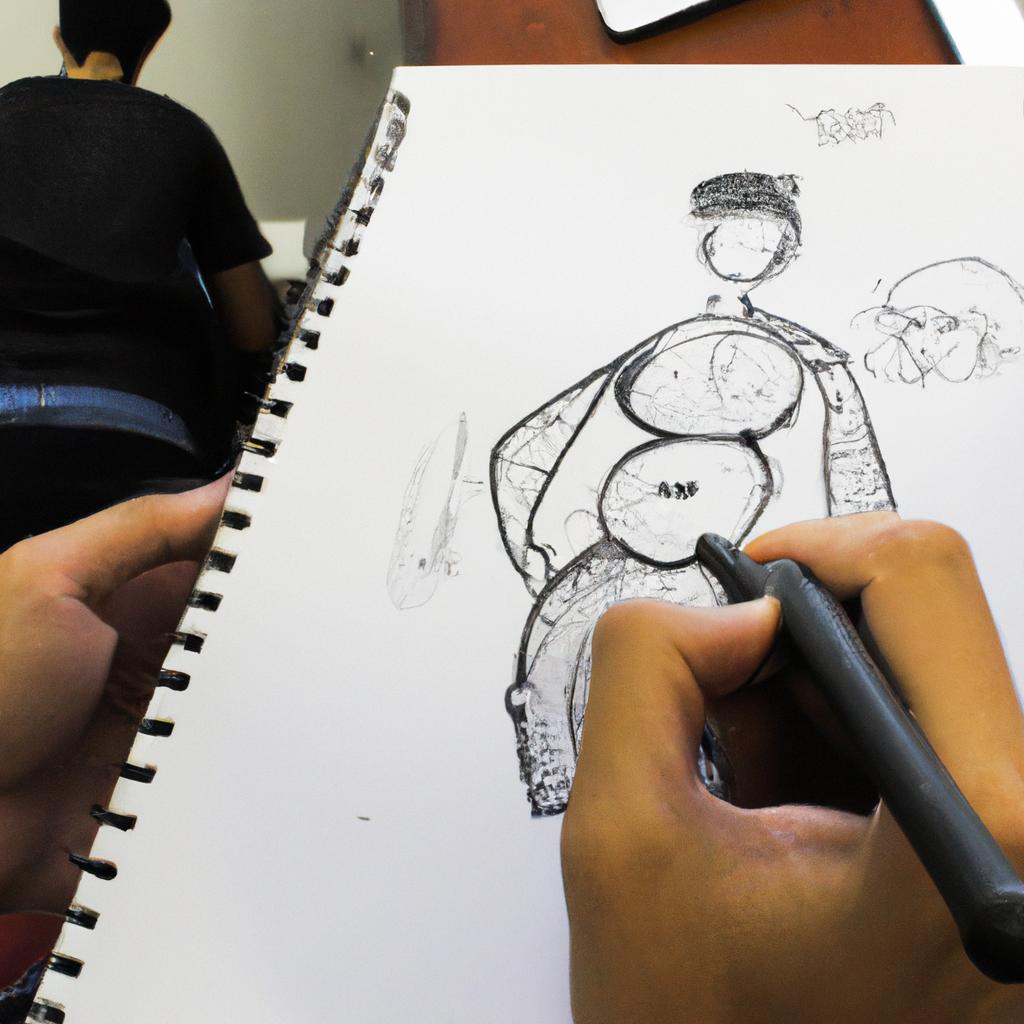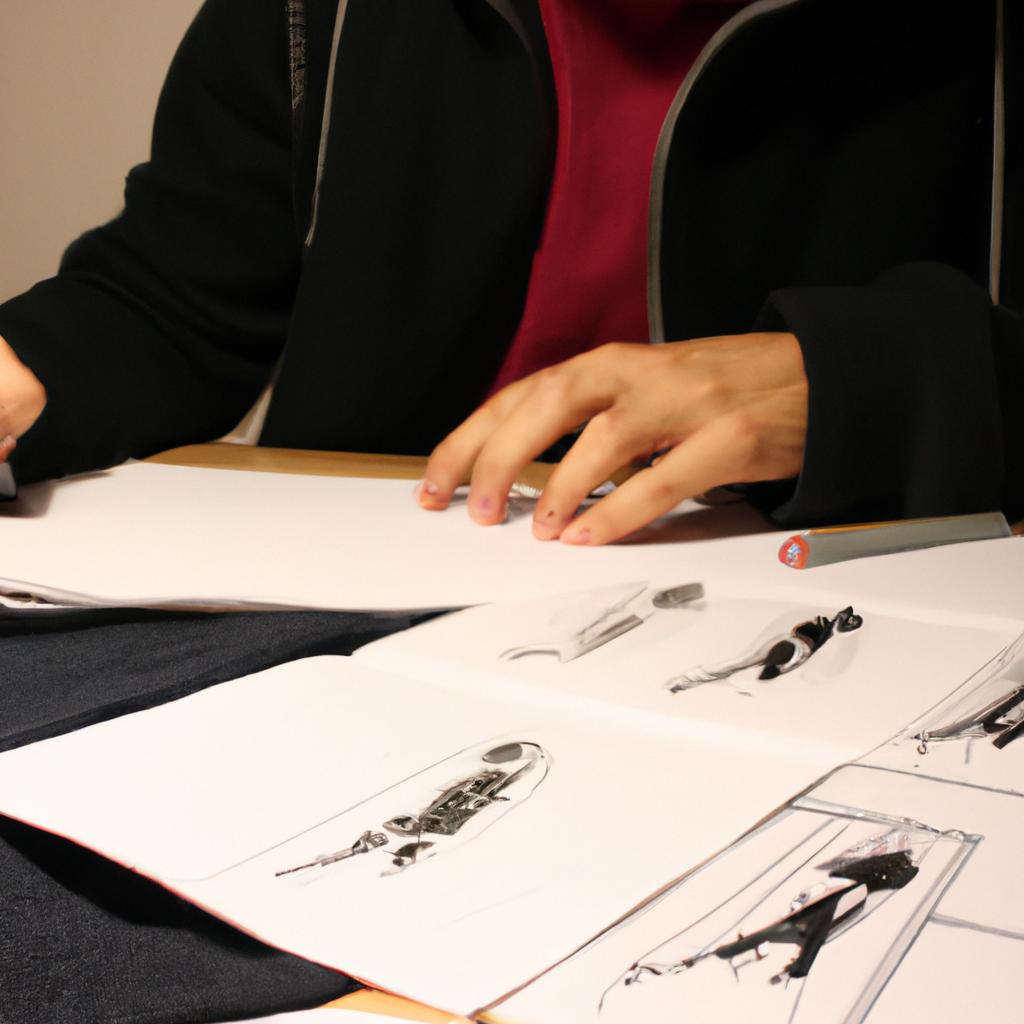Gesture and posing play a crucial role in the realm of arts and illustration, particularly when it comes to character design. Through strategic use of gestures and poses, artists are able to convey emotions, tell stories, and bring their characters to life. This article aims to delve into the importance of gesture and posing in arts and illustration, shedding light on how these elements contribute to the overall effectiveness of character design.
One captivating instance where gesture and posing can greatly impact character design is through the portrayal of superheroes. Imagine a hypothetical scenario where an artist is tasked with creating a new superhero for a comic book series. By carefully considering the gestures and poses adopted by this hero, the artist has the power to communicate strength, agility, or even vulnerability. A dynamic pose showcasing a strong stance might embody confidence and power while a hunched posture could evoke weakness or secrecy. In this case study example alone, we witness how gesture and posing serve as powerful tools for expressing different aspects of a character’s personality.
The exploration of gesture and posing in arts and illustration not only offers insight into character development but also contributes to enhancing visual storytelling techniques. Understanding how various poses can influence viewers’ perceptions enables artists to effectively convey narratives through body language alone. Whether it be capturing a fleeting moment frozen in time, or depicting a character in the midst of action, the strategic use of gesture and posing can evoke a range of emotions and engage viewers in the story being told.
Furthermore, gesture and posing can also be used to convey relationships between characters. By positioning characters in relation to one another, artists can depict hierarchy, intimacy, tension, or camaraderie. A simple touch or a subtle tilt of the head can communicate volumes about the dynamics at play within a scene.
In addition to character development and storytelling, gesture and posing also contribute to the overall composition and visual appeal of an artwork. The placement and arrangement of characters within a composition can create balance, movement, and focal points. A well-executed pose can draw attention to important elements or guide the viewer’s eye through the piece.
To effectively utilize gesture and posing in arts and illustration, artists often study anatomy, body language, and observe real-life human interactions. They experiment with different poses and gestures until they find ones that accurately portray their intended message. Additionally, artists may also incorporate references such as photographs or models to ensure accuracy and authenticity in their work.
In conclusion, gesture and posing are essential elements in character design that allow artists to convey emotions, tell stories, establish relationships between characters, enhance visual storytelling techniques, and create visually appealing compositions. Through strategic use of these elements, artists are able to bring their characters to life on paper or digital platforms while engaging viewers in captivating narratives.
Understanding the importance of gestures and posing in visual storytelling
Understanding the Importance of Gestures and Posing in Visual Storytelling
Imagine a scene where a character stands tall with their chest puffed out, shoulders squared, and arms crossed. This pose exudes confidence and authority, instantly conveying to the audience that this character is strong-willed and commanding. Such is the power of gestures and posing in visual storytelling. Whether it be in arts or illustration, understanding how body language can shape our perception of characters is crucial for effective storytelling.
Gestures and posing serve as nonverbal communication tools within visual narratives, enabling artists to convey emotions, personality traits, and narrative elements without relying solely on dialogue or text. Through deliberate choices in body positioning, facial expressions, hand movements, and overall posture, artists can breathe life into their characters and enhance the overall impact of their artwork.
To appreciate the significance of gestures and posing further, let us explore four key reasons why they play a pivotal role in visual storytelling:
- Expressiveness: Gestures allow artists to express complex emotions that may be difficult to articulate through words alone. A simple tilt of the head or an arched eyebrow can communicate feelings such as curiosity, surprise, or skepticism more effectively than any written description.
- Characterization: Posing helps establish distinct personalities for each character by showcasing their unique mannerisms and physicality. The way a character carries themselves can reveal aspects of their background, occupation, or temperament.
- Narrative Context: Body language provides valuable clues about the current situation or plot development within a visual story. For instance, a clenched fist might indicate impending conflict or tension while relaxed postures could suggest harmony or contentment.
- Engagement: Well-executed gestures draw viewers into the artwork by evoking emotional responses from them. By capturing attention through dynamic poses or thought-provoking actions, artists create an immersive experience that resonates with audiences emotionally.
In summary, gestures and posing are essential tools in visual storytelling. They allow artists to express emotions, establish character traits, enhance narrative context, and engage viewers on a deeper level. In the subsequent section, we will delve into exploring the role of gestures in conveying emotions and personality, building upon the foundation laid by understanding their importance in visual storytelling.
| Gesture | Emotion Conveyed |
|---|---|
| Clenched fists | Anger or frustration |
| Open arms with raised eyebrows | Surprise or excitement |
| Slumped shoulders and downward gaze | Sadness or disappointment |
| Hand covering mouth | Shock or disbelief |
[Continue writing about ‘Exploring the role of gestures in conveying emotions and personality’]
Exploring the role of gestures in conveying emotions and personality
Understanding the importance of gestures and posing in visual storytelling is crucial for creating compelling characters in arts and illustration. By effectively utilizing gestures, artists can convey emotions, personalities, and narratives through their artwork. In this section, we will delve into the role of gestures in conveying emotions and personality further.
One example that illustrates the significance of gestures is a character design case study involving an artist developing a protagonist for a graphic novel. Through deliberate use of specific poses and hand movements, the artist successfully portrays the character’s determination and resilience. The protagonist’s raised fist signifies strength and resolve, while their tensed muscles suggest determination to overcome obstacles. Such attention to detail in gestural representation enhances the audience’s connection with the character on an emotional level.
To explore how gestures can evoke various emotions and personalities in character design, consider these key points:
- Body posture: Different postures communicate different messages; a slouched or hunched position may convey sadness or defeat, whereas standing tall might indicate confidence or pride.
- Facial expressions: Emotions such as happiness, anger, fear, or surprise can be portrayed through facial expressions like smiles, frowns, raised eyebrows, or wide-open eyes.
- Hand movements: Hands are incredibly expressive; clenched fists display aggression or determination while gentle finger touches reveal tenderness or curiosity.
- Overall body language: The combination of all aspects of body language contributes to conveying a coherent message about a character’s personality traits and emotional state.
The table below provides a summary of common emotions conveyed through various types of gesture:
| Gesture Type | Emotion Conveyed |
|---|---|
| Outstretched arms | Openness/Invitation |
| Crossed arms | Defensiveness |
| Clenched fists | Anger/Determination |
| Slumped shoulders | Sadness/Defeat |
By understanding how each type of gesture elicits certain emotional responses from viewers/readers, artists can effectively convey the intended emotions and personalities of their characters.
Transitioning into the subsequent section about “The impact of body language on character development,” we will now explore how gestures and posing contribute to a more holistic understanding of a character’s persona. Understanding body language is essential for creating believable and relatable characters, as it not only communicates emotions but also provides insights into their motivations, intentions, and internal struggles.
The impact of body language on character development
Exploring the role of gestures in conveying emotions and personality has shed light on how artists and illustrators can bring their characters to life. By understanding the impact of body language, creators have unlocked a powerful tool for character development. As we delve further into this topic, let us consider an example that illustrates the significance of gestures.
Imagine a stoic protagonist facing a daunting challenge. Through deliberate positioning of their body, such as hunched shoulders or clenched fists, the artist can convey tension and determination. This not only enhances the visual representation but also allows viewers to connect emotionally with the character’s struggle.
To fully grasp the implications of gesture in art and illustration, here are some key aspects to consider:
- Body Proportions: The size and shape of various parts of the body play a crucial role in expressing different emotions. For instance, elongated limbs might denote elegance or vulnerability, while broad shoulders can signify strength or authority.
- Facial Expressions: The face is a canvas for communicating emotions effectively. Subtle changes like raised eyebrows or downturned lips can dramatically alter the perception of a character’s disposition.
- Hand Gestures: Hands possess incredible expressive potential; they can reveal confidence through open palms or apprehension through clenched fists. Additionally, hand placement relative to other elements within an artwork influences its overall composition.
- Posture and Stance: The way characters carry themselves provides insight into their personality traits. A relaxed posture may suggest ease and approachability, whereas rigid stance could indicate rigidity or defensiveness.
Now let us examine these concepts further by analyzing them alongside another critical element—posing—in order to enhance narrative and composition.
[Table]Analyzing the use of poses to enhance narrative and composition reveals yet another dimension in character design—one that complements gestures seamlessly. By skillfully combining both elements, artists can create dynamic visuals that captivate audiences and tell compelling stories without relying solely on dialogue or explicit narrative cues. Understanding how poses and gestures work in tandem is key to achieving this synergy.
Moving forward, let us delve into the relationship between posing and storytelling, examining various techniques employed by artists to convey their intended messages effectively.
Analyzing the use of poses to enhance narrative and composition
Transitioning from the previous section that explored the impact of body language on character development, we now delve into the analysis of poses and their role in enhancing narrative and composition. Understanding how different poses can convey specific emotions or further storytelling is crucial for artists and illustrators alike.
Imagine a scene where a superhero stands tall with one hand on their hip, chest puffed out, exuding strength and confidence. This pose instantly communicates power to the viewer without any need for words. It showcases the character’s personality and sets the tone for their story. The use of dynamic poses not only adds visual interest but also helps establish a connection between the audience and the character they are observing.
To illustrate this further, let us consider four key ways in which poses enhance narratives:
- Emotional Expression: Poses allow artists to depict various emotional states, whether it be joy, sadness, anger, or fear. By carefully selecting an appropriate pose, creators can effectively communicate these emotions to viewers.
- Characterization: Different characters have distinct personalities and traits. Posing can help emphasize these qualities; for example, a timid character may be depicted hunched over or closed off while an adventurous character might strike bold and daring stances.
- Storytelling Elements: Poses contribute to conveying movement within static images—enabling artists to create action sequences or imply motion through implied lines or exaggerated gestures.
- Composition Enhancement: Thoughtfully chosen poses can improve overall visual balance and harmony within an artwork. They guide viewers’ eyes towards focal points and direct attention to important details.
Consider the following table showcasing examples of poses used in popular illustrations:
| Pose | Emotion | Character Trait |
|---|---|---|
| Arms crossed | Defiance | Assertiveness |
| Head tilted | Curiosity | Inquisitiveness |
| Hands on hips | Confidence | Leadership |
| Crouched position | Fear | Vulnerability |
By incorporating these various poses into their work, artists and illustrators can evoke emotional responses in the audience, effectively enhancing the narrative and composition of their artwork.
Transitioning seamlessly into the subsequent section about “Techniques for creating dynamic and expressive character gestures,” let us now explore how artists achieve fluidity and expressiveness through intentional body language.
Techniques for creating dynamic and expressive character gestures
Transitioning from the previous section, where we explored the use of poses to enhance narrative and composition, let us now delve into techniques for creating dynamic and expressive character gestures. To better understand the significance of body language in character design, consider this hypothetical scenario:
Imagine a comic book panel depicting a superhero standing tall with their chest puffed out, fists clenched tightly by their sides, exuding an air of confidence and determination. This powerful pose instantly communicates the hero’s strength and readiness to take on any challenge. By utilizing effective gesture and posing techniques, artists can breathe life into their characters and evoke specific emotions or reactions from viewers.
To create compelling character gestures that resonate with audiences, it is essential to consider various factors:
- Proportions: Properly proportioned figures lend credibility to characters’ actions and make them more relatable.
- Contrasting lines: Combining straight lines with curved ones creates visual interest and adds depth to poses.
- Weight distribution: Understanding how weight shifts within a figure allows artists to convey balance or imbalance effectively.
- Expressive details: Small nuances like hand positioning or facial expressions can significantly contribute to conveying emotion.
Consider the following table highlighting different types of gestures commonly utilized in character illustration:
| Gesture Type | Description |
|---|---|
| Open palms | Signifies honesty or openness |
| Clenched fist | Conveys anger or determination |
| Raised eyebrows | Indicates surprise or curiosity |
| Hunched shoulders | Suggests fear or vulnerability |
By skillfully incorporating these elements into their work, illustrators can elicit emotional responses from viewers while enhancing storytelling through body language. The interplay between gestures, poses, and storytelling in illustration will be further examined in the subsequent section.
[Transition sentence] Expanding our exploration beyond individual characteristics, we will now shift our focus towards analyzing how gestures and poses contribute to the overall narrative and composition of illustrations.The interplay between gestures, poses, and storytelling in illustration
By understanding how these elements work together, artists can create compelling visual narratives that captivate viewers.
Gestures and poses serve as powerful tools for conveying emotions, actions, and character traits within an illustration. For instance, let’s consider a hypothetical case of an artist designing a fantasy character named Aria who is known for her agility and grace. To showcase Aria’s swift movements and nimble nature, the artist might depict her mid-leap with one leg extended behind her while her arms are gracefully positioned to enhance the sense of motion. This dynamic pose not only captures Aria’s physical capabilities but also conveys her adventurous spirit.
To further emphasize the impact of gestures and poses on storytelling within illustrations, we can examine specific techniques employed by artists:
- Contrasting Gestures: Using opposing or contrasting gestures within a composition can create tension or highlight different moods. For example, pairing a clenched fist with an open palm suggests conflict or internal struggle.
- Gesture Hierarchy: Establishing a clear hierarchy among multiple characters through their gestures helps guide viewers’ attention and establishes relationships within the narrative.
- Body Language: Manipulating body language allows artists to communicate subtle nuances about a character’s personality. The tilt of a head or a slight slouch can convey vulnerability or confidence respectively.
- Expressive Poses: Experimenting with exaggerated or unconventional poses adds interest and depth to characters, making them more visually engaging for audiences.
In addition to these techniques, illustrators often utilize tables as valuable resources during their creative process. Here is an example table showcasing various common emotional states along with associated gesture suggestions:
| Emotional State | Suggested Gestures |
|---|---|
| Happiness | Smiling widely |
| Sadness | Slumped shoulders |
| Anger | Clenched fists, furrowed brow |
| Surprise | Wide eyes, open mouth |
By referencing tables like this one, artists can effectively convey emotions through purposeful gestures and poses while maintaining consistency in their illustrations.
In summary, the interplay between gestures, poses, and storytelling is a crucial aspect of illustration. By employing techniques such as contrasting gestures and expressive poses, artists can create visually captivating narratives that evoke emotional responses from viewers. Additionally, utilizing tables as resources for gesture suggestions provides illustrators with valuable guidance when aiming to communicate specific emotional states within their artwork.
 PSP Oste
PSP Oste



